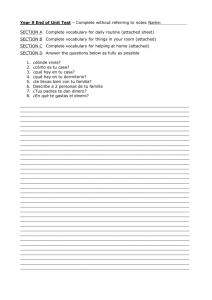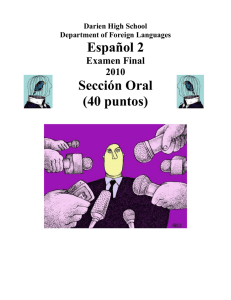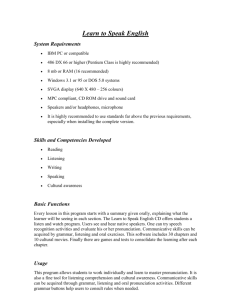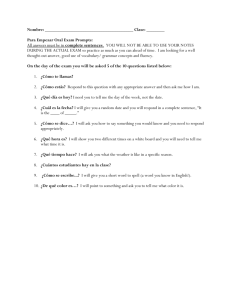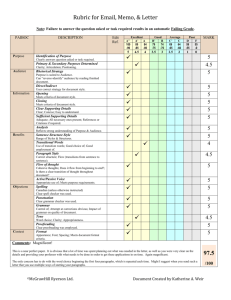QCC COURSE ASSESSMENT FORM QCC C A
advertisement
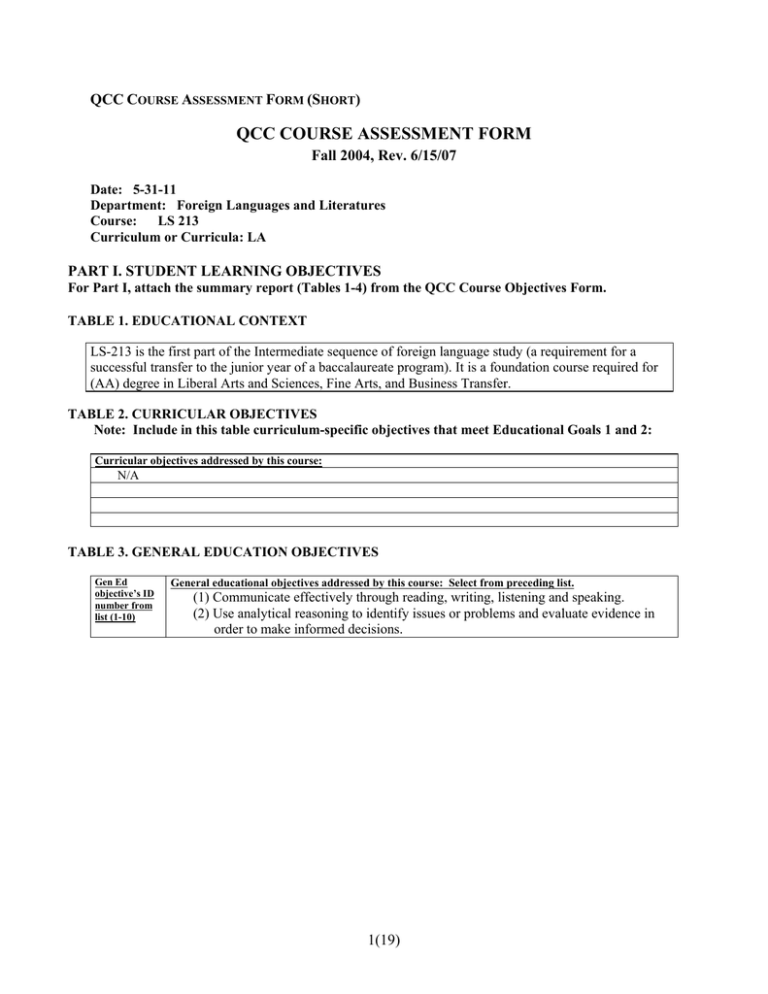
QCC COURSE ASSESSMENT FORM (SHORT) QCC COURSE ASSESSMENT FORM Fall 2004, Rev. 6/15/07 Date: 5-31-11 Department: Foreign Languages and Literatures Course: LS 213 Curriculum or Curricula: LA PART I. STUDENT LEARNING OBJECTIVES For Part I, attach the summary report (Tables 1-4) from the QCC Course Objectives Form. TABLE 1. EDUCATIONAL CONTEXT LS-213 is the first part of the Intermediate sequence of foreign language study (a requirement for a successful transfer to the junior year of a baccalaureate program). It is a foundation course required for (AA) degree in Liberal Arts and Sciences, Fine Arts, and Business Transfer. TABLE 2. CURRICULAR OBJECTIVES Note: Include in this table curriculum-specific objectives that meet Educational Goals 1 and 2: Curricular objectives addressed by this course: N/A TABLE 3. GENERAL EDUCATION OBJECTIVES Gen Ed objective’s ID number from list (1-10) General educational objectives addressed by this course: Select from preceding list. (1) Communicate effectively through reading, writing, listening and speaking. (2) Use analytical reasoning to identify issues or problems and evaluate evidence in order to make informed decisions. 1(19) TABLE 4: COURSE OBJECTIVES AND STUDENT LEARNING OUTCOMES Course objectives Accomplish complex communicative tasks. Read and comprehend authentic reading material including newspaper or magazine articles, and passages from contemporary literary works. Formulate opinions; make judgments and/or suggestions, in oral and/or written form, on selected issues presented in the reading material. Summarize a narrative text, or create one on their own. Learning outcomes Students will be able to 1. Identify characteristics and facts about Hispanic communities 2. Describing people and their activities 3. Comparing and contrasting people’s customs and beliefs 4. Narrating in the past 5. Discussing language variation and language use 6. Describing events, people, and objects in the past 7. Talking about legends and traditions 8. Analyzing past and present cultural practices 9. Describing the origins, purposes, and features of cultural products 10. Expressing preferences and tastes 11. Talking about artistic expression 2(19) PART II. ASSIGNMENT DESIGN: ALIGNING OUTCOMES, ACTIVITIES, AND ASSESSMENT TOOLS For the assessment project, you will be designing one course assignment, which will address at least one general educational objective, one curricular objective (if applicable), and one or more of the course objectives. Please identify these in the following table: TABLE 5: OBJECTIVES ADDRESSED IN ASSESSMENT ASSIGNMENT Course Objective(s) selected for assessment: (select from Table 4) 1. Provide information in Spanish on topics such Hispanic identity and diversity, ethnics groups, diversity and identity expressed through language, Spanglish, the Spanish-speaking community in the United States, legends and traditions, sculpture, painting and music. 2. Demonstrate ability to accomplish communicative tasks such as comparing and contrasting people’s customs and beliefs, narrating in the past, describing events, people and objects in the past, analyzing past and present cultural practices, expressing preferences and tastes and talking about artistic expression. Curricular Objective(s) selected for assessment: (select from Table 2) N/A General Education Objective(s) addressed in this assessment: (select from Table 3) 1. Communicate effectively through reading, writing, listening and speaking. 2. Use analytical reasoning to identify issues or problems and evaluate evidence in order to make informed decisions. In the first row of Table 6 that follows, describe the assignment that has been selected/designed for this project. In writing the description, keep in mind the course objective(s), curricular objective(s) and the general education objective(s) identified above, The assignment should be conceived as an instructional unit to be completed in one class session (such as a lab) or over several class sessions. Since any one assignment is actually a complex activity, it is likely to require that students demonstrate several types of knowledge and/or thinking processes. Also in Table 6, please a) identify the three to four most important student learning outcomes (1-4) you expect from this assignment b) describe the types of activities (a – d) students will be involved with for the assignment, and c) list the type(s) of assessment tool(s) (A-D) you plan to use to evaluate each of the student outcomes. (Classroom assessment tools may include paper and pencil tests, performance assessments, oral questions, portfolios, and other options.) Note: Copies of the actual assignments (written as they will be presented to the students) should be gathered in an Assessment Portfolio for this course. 3(19) TABLE 6: ASSIGNMENT, OUTCOMES, ACTIVITIES, AND ASSESSMENT TOOLS Briefly describe the assignment that will be assessed: This project will assess students’ overall abilities. Their conversational abilities will be assessed by engaging them in role-play activities where both they and the instructor play a specific role. Students may play the role of a person looking for a job at a Hispanic Community Center, a person talking with his/her best friend after spending several years in Latin America or a guide specialized in Pre Colombian Art and Civilizations at a museum. See Appendix 1 for a description of the oral exam Their listening, reading and writing abilities as well as their knowledge of grammar and vocabulary will be assessed by a comprehensive final exam. See appendix 1 for a description of the final exam. Desired student learning outcomes for the assignment (Students will…) List in parentheses the Curricular Objective(s) and/or General Education Objective(s) (1-10) associated with these desired learning outcomes for the assignment. Gen-Ed objective (1) Communicate effectively through reading, writing, listening and speaking. (2) Use analytical reasoning to identify issues or problems and evaluate evidence in order to make informed decisions. Curricular objectives N/A Briefly describe the range of activities student will engage in for this assignment. Speaking abilities. Students will engage in a role-play activity with his/her instructor. The activity is designed so that it can be completed in 7-10 minutes interaction, students will select at random one of three situations: at a Community Center, at a museum and at a coffee shop Listening comprehension: listen to two paragraphs and answer true/false and multiple choice questions. Reading activity: read two passages and answer questions. Vocabulary activity: complete three sections with the appropriate vocabulary. What assessment tools will be used to measure how well students have met each learning outcome? (Note: a single assessment tool may be used to measure multiple learning outcomes; some learning outcomes may be measured using multiple assessment tools.) Oral interview. Role-play activity: Students will be asked to complete a task where they need to look for a job at a Hispanic Community Center, or have a conversation with a friend at the coffee shop, or guide someone in a museum. They will be assessed using the rubric for oral assessment designed by the department (See appendix 1 for a detailed description) Students will be asked to listen to two passages and answer questions. (See appendix 1) Students will be asked to read two paragraphs and answer questions. (See appendix 1) Students will be asked to provide the correct vocabulary in three exercises. (See appendix 1) Grammar activities: complete seven sections with the appropriate words. Students will be asked to complete sentences using the correct word. (See appendix 1) Writing activities: write a paragraph in the past about your life. Students will be asked to give information about their past life. They will be assessed using the rubric for written assessment designed by the department (See appendix 1) 4(19) PART III. ASSESSMENT STANDARDS (RUBRICS) Before the assignment is given, prepare a description of the standards by which students’ performance will be measured. This could be a checklist, a descriptive holistic scale, or another form. The rubric (or a version of it) may be given to the students with the assignment so they will know what the instructor’s expectations are for this assignment. Please note that while individual student performance is being measured, the assessment project is collecting performance data ONLY for the student groups as a whole. TABLE 7: ASSESSMENT STANDARDS (RUBRICS) Brief description of assignment: (Copy from Table 6 above) This project will assess students’ overall abilities. Their conversational abilities will be assessed by engaging them in role-play activities where both they and the instructor play a specific role. Students may play the role of a person looking for a job at a Hispanic Community Center, or a person explaining his/her experience living in Latin America or a guide specialized in Pre Colombian Art and Civilizations. Oral tasks will prompt the students with questions. Their listening, reading and writing abilities as well as their knowledge of grammar and vocabulary will be assessed by a comprehensive final exam. See appendix 1 for a description of the final exam. Desired student learning outcomes from the assignment: (Copy from Column 1, Table 6 above; include Curricular and /or General Education Objectives addressed) Gen-Ed objectives (1) Communicate effectively through reading, writing, listening and speaking. 2) Use analytical reasoning to identify issues or problems and evaluate evidence in order to make informed decisions. Curricular objectives N/A Assessment measures for each learning outcome: (Copy from Column 3,Table 6 above) Students will be asked to complete a task where they need to exchange information at a museum, at a coffee shop or at a Hispanic Community Center Students will be asked to listen to two passages and answer questions. Students will be asked to read two paragraphs and answer questions. Students will be asked to provide the correct vocabulary in three exercises. Students will be asked to complete sentences using the correct word. Students will be asked to give personal information Standards for student performance: The parameters for measuring students’ speaking abilities will be to determine whether: (i) they understand the questions being asked by the interlocutor and they respond without probing, (ii) they speak continuously with few pauses or stumbling, (iii) they are understood by the interlocutor by using the correct intonation and pronunciation, (iv) they speak with some degree of fluidity, (v) they use correctly the required grammatical structures and (vi) they use the appropriate vocabulary Students’ listening comprehension ability will be determined by calculating their accuracy rates in providing the correct answers to the questions asked. 75 per cent of them are expected to meet the course standards (80% accuracy rate). Students’ reading comprehension ability will be determined by calculating their accuracy rates in providing the correct answers to the questions asked. 75 per cent of them are expected to meet the course standard (80% accuracy rate). Students’ vocabulary knowledge will be determined by calculating the accuracy rates in providing the correct words or phrases in a given situation. 75 per cent of them are expected to meet the course standard (80% accuracy rate). Students’ grammar knowledge will be determined by calculating their accuracy rates in providing the correct forms or structures. 75 per cent of them are expected to meet the course standards (80% accuracy rate). 5(19) The parameters used to measure students’ writing abilities will be to determine whether: (i) they will provide all the information they have been asked, (ii) their writing displays a vocabulary appropriate to their proficiency level, (iii) they show an adequate control of the syntactic structures for a Spanish beginning level class, (iv) their sentences are fully developed, even though sporadically connected. 75% of the students tested are anticipated to meet the course’s expectations as described in the attached rubric. PART IV. ASSESSMENT RESULTS TABLE 8: SUMMARY OF ASSESSMENT RESULTS Use the following table to report the student results on the assessment. If you prefer, you may report outcomes using the rubric(s), or other graphical representation. Include a comparison of the outcomes you expected (from Table 7, Column 3) with the actual results. NOTE: A number of the pilot assessments did not include expected success rates so there is no comparison of expected and actual outcomes in some of the examples below. However, projecting outcomes is an important part of the assessment process; comparison between expected and actual outcomes helps set benchmarks for student performance. TABLE 8: SUMMARY OF ASSESSMENT RESULTS Desired student learning outcomes: (Copy from, Column 1,Table 6 above; include Curricular and/or General Education Objectives addressed) Student achievement: Describe the group achievement of each desired outcome and the knowledge and cognitive processes demonstrated. Gen-Ed objectives See Table 9. Communicate effectively through reading, writing, listening and speaking. Curricular objectives N/A TABLE 9. EVALUATION AND RESULTING ACTION PLAN In the table below, or in a separate attachment, interpret and evaluate the assessment results, and describe the actions to be taken as a result of the assessment. In the evaluation of achievement, take into account student 6(19) success in demonstrating the types of knowledge and the cognitive processes identified in the Course Objectives. A. Analysis and interpretation of assessment results: What does this show about what and how the students learned? 1. Speaking task. Oral interview: Data from 36 students that completed the speaking task in Spanish was gathered. Their performance was rated according to 5 parameters; listening comprehension, fluidity, pronunciation, vocabulary and grammar. Student performance was scored using the scoring rubric (see Appendix 1) Table 1 Average Score in Each Category of 36 students Listening Fluidity Pronunciation Vocabulary Grammar Total Range 4 4 4 4 4 Average Score 3.47 3.02 3.18 0‐20 2.7 2.58 15.04 The total points a student could achieve (adding up all five parameters, each worth a maximum of four points) was 20. The scale agreed upon beforehand by the Assessment Committee defined the following ranges:0-5 points = student performance does not meet expectations; 6-10 points = student performance almost meets expectations; 1115 points = student performance meets expectations:16-20 student performance exceeds expectations The average of total points achieved by students tested in Spanish was 15,4. According to the scale, this average falls between the range of meets expectations and exceeds expectations. The assessment Committee also predicted that 75% of students tested would achieve a score indicating that their performance meets expectations. The results of students who achieved each performance level in Spanish are the following: Table 2 Range # 0f 36 Students Percentage Percentage of Students in Each Proficiency Level Does not meet Almost meets Meets expectations expectations expectations 0‐5 6‐10 11‐15 0 6 0% Exceed expectations 16‐20 11 19 17% 30% 53% 2. Written Final Examination The data of 37 students that completed the final exam (assessment tool) in Spanish was gathered. Their performance was rated according to five categories: listening comprehension, vocabulary, grammar, reading and writing. The results are as follows: Table 3 Average Score in Each Category Listening Vocabulary Grammar Reading Writing Total Range 0‐16 0‐16 0‐36 0‐16 0‐16 0‐100 Average Score 14.1 9.8 21 7(19) 12.3 10.9 68.1 # of Students 37 37 37 37 37 37 The average score achieved was 68.1% The total points a student could achieve (adding up all five categories) was100. The scale agreed upon beforehand by the Assessment Committee defined the following ranges: 0-60points= student performance does not meet expectations; 61–73 points= student performance almost meets expectations; 74-89 points= student performance meets expectations; 90-100= student performance exceeds expectations. Table 4 Range Percentage of Students in Each Proficiency Level Does not meet Almost meets Meets expectations expectations expectations 0‐60 61‐73 74‐89 # 0f Students Percentage Exceed expectations 90‐100 13 10 10 4 35% 27% 27% 11% The overall student performance shows that only 38% of students meet o exceed expectations. The results for percentage of students in each category are as follows: Table 5 Range # 0f Students Percentage Table 6 Range # 0f Students Percentage Table 7 LISTENING. Student performance… Does not meet expectations 0‐6 Almost meets expectations 6.5‐9.5 Meets expectations 10‐13.5 Exceed expectations 14‐16 0 0 10 27 0% 0% 27% 73% VOCABULARY. Student performance … Does not meet expectations 0‐6 Almost meets expectations 6.5‐9.5 Meets expectations 10‐13.5 Exceed expectations 14‐16 10 7 13 7 27% 19% 35% 19% GRAMMAR. Student performance … 8(19) Range Does not meet expectations 0‐16 # 0f Students Percentage Table 8 Range Range # 0f Students Percentage Meets expectations 23‐30.5 Exceed expectations 31‐36 12 11 9 5 32% 30% 24% 14% READING. Student performance … Does not meet Almost meets expectations expectations 0‐6 6.5‐9.5 # 0f Students Percentage Table 9 Almost meets expectations 16.5‐22.5 Meets expectations 10‐13.5 Exceed expectations 14‐16 1 1 21 14 3% 3% 57% 38% WRITING. Student performance … Does not meet Almost meets expectations expectations 0‐6 6.5‐9.5 Meets expectations 10‐13.5 Exceed expectations 14‐16 3 10 16 8 8% 27% 43% 22% B. Evaluation of the assessment process: What do the results suggest about how well the assignment and the assessment process worked both to help students learn and to show what they have learned? The results of the speaking task in Spanish show that, as predicted, at least 75% of students tested meet or exceed expectations on overall performance of the task: the actual percentage of student tested in Fall 2011 that meet or exceed expectations is 83%. The largest portion of students (53%) fell into the category rated as exceeding expectations. If we look at student performance according to individual parameters, the highest average scores was in listening comprehension and pronunciation, the second average score was fluidity. The two lowest scoring parameters were vocabulary and grammar The results in the writing, vocabulary and grammar categories show that 38% of students meet o exceed expectations. The actual percentage of students tested who meet or exceed expectations in vocabulary is 54%, in grammar is 38%, in reading is 95%, in writing is 65% and in listening is 100% B2) Evaluation of the assessment The results obtained seem to indicate that the assessment tools used and the assessment process undertaken have been effective in determining our students´proficiency level The results obtained seem to indicate that the assessment tools used and the assessment process undertaken has been successful in accurately determining our students’ proficiency level. C. Resulting action plan: 9(19) Based on A and B, what changes, if any, do you anticipate making? The overall average achieved by students on the speaking task in Spanish shows a satisfactory result with 83% of students meeting expectations as defined by the Assessment Committee. The average achieved on each individual parameter in Spanish show areas of relative strength, as well as two areas of relative weakness: vocabulary and grammar. The overall average achieved by students on the assessment in Spanish shows an unsatisfactory result. Only 38% of the students meet or exceed the expectations. The averages achieved on each individual category in Spanish show that the areas that need to improve are vocabulary, grammar and writing. The weakest area is grammar (38%) followed by vocabulary (54%) and writing (65%). These results need to be addressed. The committee will meet in the fall to discuss the results and determine recommendations. It will then share and discuss the recommendations with the faculty. Conclusion and Action Plan The acquisition scenario among the foreign languages evaluated (Italian, Spanish and French) lacks uniformity. As Table 1 shows, in the three languages, the number of students reaching the proficiency levels set up for an intermediate language course (LX213) ranges from 100% (Italian) to 67% (French), and 38% (Spanish). Members of the committee seem to have diverging opinions on the assessment tools and on the scoring scale used to achieve these results. Therefore, the committee will reconvene to discuss at length on the actions to take, the significance of the results, and the re-evaluation of the assessment tools and the scoring scales used. Table 1 LX213 Percentage of Students in Each Proficieny Level (except oral) 70 60 50 40 30 20 10 0 Italian Spanish French Does not meet expectations (0‐60) 0 35 17 Almost meets expectations (61‐73) 0 27 17 Meets expectations (74‐89) 62 27 42 Exceeds expectations (90‐100) 38 11 25 In fact, as shown in Table 2, the average score of Spanish students was 68.1% vs. 79.5% (French) and 85.3% (Italian), indicating that their overall performance was significantly below the course expectations (74 to 89). Interestingly, such discrepancies were also noticed in a previous assessment of beginners II during the academic year 2010-2011. Table 2 10(19) Spanish students scored lower than the Italian and French learners, even though all three language groups reported some weaknesses in the Vocabulary, Grammar and Writing areas. In other words, they showed a general lack of grammatical accuracy and poor assimilation of the vocabulary which has affected the quality of their written production. Table 3 Table 3 indicates the average score in each category: listening, vocabulary, grammar, reading and writing. Table 4 Table 3 indicates the average score in the overall oral assessment. The results in the oral assessment do not show the same discrepancies as in the overall written seen above. 11(19) In the oral assessment none of the students was in the “does not meet expectation” category (compared to 35% in the written assessment, see above). Aside from that, only 17 percent performed below the “Meets expectations level.” As Table 5 shows, students in all three languages performed better than in the written assessment. It shows that 83% of the students of Spanish met expectations, which is 8% above the 75 percent which is normally expected, while all students of Italian and students of French met or exceeded the expectations. Table 5 Despite the performance above the expected 75 percent of all students of the three languages, a closer look at the data reveals that there are divergences among the three language groups in all areas (see Table 6 below). For instance, the three groups of learners did not report visible difficulty in understanding the instructor, and using the target language with appropriate speed and pronunciation. However, similarly to the written test, their use of the vocabulary and their grammatical accuracy was not as native-like. The most affected were the Spanish learners followed by the French ones. In Table 6 below the results of French in the oral assessment are not consistent with the results in the written 12(19) assessment, especially in the vocabulary and grammar results. The students of French exceed the performance of students of Italian in the oral grammar category, which was not the case in the written assessment. In the vocabulary area, the students of French performed worse in the oral assessment than the students of Spanish, but in the written assessment they had exceeded the performance of the students of Spanish. Table 6 4.5 4 3.5 3 2.5 2 1.5 1 0.5 0 LX213 Oral Assessment Average Score in Each Category Listening Fluidity Pronunciation Vocabulary Grammar 4 4 4 4 4 Italian 3.6 3.6 3.6 3.1 3.1 Spanish 3.5 3 3.2 2.7 2.6 French 3.7 3.7 3.9 2.1 3.5 Maximum score In sum, data collected shows that, although students tend to do better in the oral task, they seem to encounter greater difficulties in properly acquiring the necessary lexical and syntactic expertise of the target language. The weaknesses in the oral assessment show that vocabulary and grammar needs improvement and in the written assessment the same two areas need more emphasis as well as writing. This situation needs to be addressed and discussed with all faculty members, and some changes in our teaching and assessment strategies need to be introduced. Students will continue to be encouraged to attend the College Learning Center where their acquisition problems may be individually addressed by the tutors. Furthermore, the educational staff of the Foreign Language Department should continue working with CETL (the Center for Excellence in Teaching and Learning) to find more effective ways to tackle and solve this problem. 13(19) APPENDICES APPENDIX 1: LS 213 - FINAL EXAM GUIDELINES A. ORAL EXAM GUIDELINES (5% of the final grade) It is a conversation: teacher-student (10 minutes) Student select AT RANDOM one of three situations (see study guide) Student should answer with complete sentences. English is not allowed. Listening comprehension, fluidity, pronunciation, vocabulary and grammar will be evaluated. For top results: a. Listening comprehension: Student fully understands the examiner’s questions, without probing. b. Fluidity: Continuous speech with few pauses or stumbling. c. Pronunciation: Excellent pronunciation. d. Vocabulary: Use the appropriate vocabulary. Student fully addresses the information requested and provides additional details. e. Grammar: Use correctly the required grammatical structures (Accuracy level 90%-100%) STUDY GUIDE PRACTICE the following situations and questions: a. in class b. with your classmates outside the classroom c. with a tutor at the Students Learning Center (L-125) Phone: 718-631-6660 d. with your Spanish speaking friends SITUACIÓN 1: JOB INTERVIEW IN A HISPANIC COMMUNITY CENTER You are going to work in a Hispanic Community Center and the director (played by your instructor) wants to know about your background and your knowledge of Hispanic Culture. What would you say, how would you answer his/her questions. This is a formal conversation (usted) - Greet each other and exchange names Give personal information Reasons to work with the Hispanic Community Questions about the language and the culture Wrap up and goodbyes POSIBLES PREGUNTAS -¿De dónde es Ud.? ¿Dónde nació? Cómo es el lugar donde nació? ¿Cuáles son sus actividades favoritas? -¿Qué aspectos de la cultura hispana le interesan? ¿Qué le fascina? ¿Qué le gusta más? ¿Qué personas famosas del mundo hispano conoce? ¿Quién le cae bien? ¿Quién le cae mal? ¿Qué sabe sobre ellas? (biografía, hechos importantes en su vida, por qué son famosas? -Puesto que Ud. quiere trabajar en este centro hispano, voy a preguntarle sobre la comunidad hispana y sobre su lengua. ¿Quiénes son los hispanos? ¿Qué importancia tiene el año 1492 para la comunidad 14(19) hispana? ¿De dónde procede principalmente la comunidad latina de Estados Unidos? ¿Cuáles son algunas de las características de esta comunidad? ¿Cuáles son algunas estrategias/formas efectivas para conocer mejor la cultura hispana en Estados Unidos? ¿El español hablado en todo el mundo es una lengua homogénea o heterogénea? ¿Cuál es el origen del español? ¿Cuándo llegó el español a América? ¿De qué lenguas ha tomado palabras el español? ¿Puede nombrar Ud. cinco palabras del español tomadas de las lenguas indígenas americanas? ¿Qué es el Spanglish? ¿Qué piensa del Spanglish? ¿Está a favor o en contra del uso del Spanglish? / ¿Para Ud. es algo positivo o negativo? ¿Por qué? SITUACIÓN 2: AT THE COFFEE SHOP You meet with your best friend (played by your instructor) at the coffee shop. You have been living in Latino America or Spain for two years. What would you say, how would you answer his/her questions. This is an informal conversation (tú) - Greet each other Memories Legends Festivities and traditions Wrap up and goodbyes POSIBLES PREGUNTAS Cuéntame sobre tu mejor viaje. ¿Adónde fuiste? ¿Qué sabías del lugar antes de visitarlo? ¿Qué descubriste al llegar al lugar? ¿Qué querías hacer allí? ¿Qué hiciste y qué no pudiste hacer? ¿A quiénes conociste allí? ¿Qué palabras nuevas aprendiste? ¿Ocurrió algo interesante mientras estabas allí? ¿Qué leyendas o tradiciones aprendiste durante tu estancia en Latinoamérica/España? ¿Te acuerdas de alguna leyenda o tradición? ¿Cuál? ¿De qué trataba/? ¿En qué festividades o eventos tradicionales participaste? ¿Dónde ocurrió el evento o la festividad? ¿Qué sabías sobre la festividad o evento antes de participar, ¿por qué querías participar? ¿Qué pudiste y que no pudiste hacer? ¿A qué personas conociste durante la festividad o evento? ¿Qué aspecto de la festividad te gustó más? ¿Cuánto tiempo hace que regresaste de tu viaje? SITUACIÓN 3: AT THE MUSEUM You are a guide at the Art Gallery specialized in Pre Colombian Art and Civilizations and your client (played by your instructor) wants to know about the history of the different items in the exhibition (see pictures) This is a informal conversation (tú) - Greet each other Talk about Pre Colombian Civilizations Express opinions Wrap up and goodbyes POSIBLES PREGUNTAS Me gustaría saber sobre las culturas precolombinas.¿Cuántas culturas precolombinas están representadas en esta galería de arte? ¿Cuál es más interesante? ¿Dónde estaban localizadas las 15(19) culturas precolombinas? ¿Cómo eran estas culturas? ¿Quiénes eran los mayas? ¿Cuáles eran los principales cultivos de las culturas precolombinas? ¿Qué tipo de artes practicaban las culturas precolombinas? ¿Qué importancia tenía la astronomía para las culturas precolombinas? ¿Cómo usaban la rueda? ¿De qué material estaban construidos los edificios precolombinos? ¿Qué función tenían las pirámides? ¿Qué eran los códices? ¿Qué tres culturas precolombinas desarrollaron la escritura pictográfica? ¿Conoces alguna leyenda precolombina? Explica (¿Cómo se llama? ¿De dónde es? ¿Quiénes son los protagonistas? ¿Qué pasó al principio y después? ¿Qué pasó al final? ¿Qué te interesa de esta leyenda? ¿Quiénes eran los incas? ¿Qué otras civilizaciones importantes había en América? ¿Qué hablaban los incas? ¿Dónde estaba esta civilización? ¿Qué arquitectura tenía? ¿Qué conocimientos tenía? Expresa tu opinión sobre tu artista (arquitecto, pintor, escritor) favorito Performance exceeds expectations Performance meets expectations Performance almostmeets expectations Performance doesnotmeet expectations IntermediateLevel(LX213andLX214)SpeakingTask‐HolisticRubric Listening Fluidity Pronunciation Vocabulary comprehension Studentfully Excellent Speech Studentfully addressesthe pronunciation continuouswith understandsthe information fewpausesor examiner’s requestedand stumbling. questions,without provides Cohesivedevices probing additionaldetails appropriatefor usingrich thislevelare vocabulary frequentlyused 4POINTS 4POINTS 4POINTS 4POINTS Studentaddresses Good Continuous Studentfully theinformation speechwithsome pronunciation understandsthe requested withafew pausesand examiner’s withoutproviding imperfections questions,butneeds stumbling. additionaldetails. Cohesivedevices occasionalprobing Studentuses aresporadically adequate used vocabulary 3POINTS 3POINTS 3POINTS 3POINTS Studentaddresses Satisfactory Speechchoppy Student lessthan60%of and/orslowwith pronunciation understandsless theexaminer’s frequentpauses. than60%ofthe questions. Rareuseof examiner’s Studentuses cohesivedevices questionsafter inadequate probing vocabulary 2POINTS 2POINTS 2POINTS 2POINTS Studentaddresses Unsatisfactory Speechhalting Student lessthan40%of pronunciation andunevenwith understandsless theexaminer’s longpauses than40%ofthe questions. questionsevenafter Studentuses probing inaccurate vocabulary. 1POINT 1POINT 1POINT 1POINT Grammar Perfectcontrolof thesyntactic structuresand grammar required. (Accuracylevel 90%‐100%) 4POINTS Adequatecontrol ofthesyntactic structures.Some grammatical errors (Accuracylevel 79%‐89%) 3POINTS Emergingcontrol ofthesyntactic structures. Several grammatical errors (Accuracylevel 61%‐78%) 2POINTS Minimalcontrol ofthesyntactic structures. Numerous grammatical errors (Accuracylevel 0%‐60%) 1POINT I.COMPRENSIÓN AUDITIVA. (16 puntos) Listen to what your instructor will read and then complete the activities. Your instructor will repeat ONLY TWICE Listening A. TRUE OR FALSE 16(19) Listening B. MULTIPLE CHOICE II.VOCABULARIO (16 puntos) Complete with the appropriate word or word expression related to: a. La leyenda de la Atlántida (p. 70, actividad 3-1, p. 73, actividad 3-4 y 3-5) b. Arquitectura y arte en la América precolombina (p. 102, actividad 4-1, 4-2, p. 107, actividad 4-4) III.GRAMÁTICA (36 puntos) Fill in the blanks or write sentences related to: a. Los verbos del pretérito (p. 41, 42 y expresiones y verbos útiles de la actividad 2-8 y 2-10) b. Los verbos en el imperfecto (p.53 y 54) c. Los verbos con diferentes equivalentes en inglés en el pretérito y el imperfecto (p.75) d. El pretérito perfecto (p. 88-89) e. Los verbos como gustar (p.121- 124) IV.COMPRENSIÓN DE LECTURA (16 puntos) Read and complete the following activities. Reading A. TRUE OR FALSE Reading B. MULTIPLE CHOICE V.COMPOSICIÓN (16 puntos) Write a paragraph about your life or about the life of a member of your family: most important events, childhood, what have you/he/she done recently, express your/his/her likes and dislikes (Minimum 100 words). THE COMPOSITION WILL BE GRADED ACCORDING TO THE WRITING TASK HOLISTIC RUBRIC Exceeds expectations Meets expectations Almost meets expectations Does not meet expectations Task Completion Superior completion of the task. Student fully addresses the information requested, and provides additional details 4 POINTS Completion of task. Student fully addresses the information provided, but does not provide additional details 3 POINTS Level of Discourse Sentences are fully developed and interconnected with cohesive devices appropriate for this level 4 POINTS Vocab. Rich use of vocabulary Grammar Perfect control of the syntactic structures required. (Accuracy level 90% - 100%) 4 POINTS 4 POINTS Sentences are fully developed. Cohesive devices are sporadically used Adequate and accurate use of vocabulary 3 POINTS 3 POINTS Partial completion of task. Student completes no more than 60% of the information requested 2 POINTS Minimal completion of task. Student completes less than 40% of the information requested. 1 POINT Sentences are somewhat complete. Rare use of cohesive devices Somewhat inadequate and/or inaccurate use of vocabulary Adequate control of the syntactic structures. Some grammatical errors (Accuracy level 79% 89%) 3 POINTS Emerging control of the syntactic structures Several grammatical errors (Accuracy level 61% - 78%) 2 POINTS Minimal control of the syntactic structures. Numerous grammatical errors (Accuracy level 0%60%) 1 POINT 2 POINTS Sentences are mostly incomplete. No use of cohesive devices 2 POINTS Inadequate and/or inaccurate use of vocabulary 1 POINT 1 POINT 17(19) APPENDIX 2: SCORING SCALES Grammar task (Range: 0 to 36) GRAMMARSECTION Performance exceeds expectations ACCURATE USE OF THE GRAMMATICAL STRUCTURES LEARNED IN THE COURSE More than 90% completion of the task (31 – 36 points) Performance meets expectations Between 74% and 89% completion of the task (23 – 30.5 points) Performance almost meets expectations Between 61% and 73% completion of the task (16.5- 22.5 points) Performance does not meet expectations Between 0% to 60% completion of the task (0 – 16 points) Vocabulary task (Range: 0 to 16) VOCABULARY SECTION Performance exceeds expectations ACCURATE AND ADEQUATE USE OF THE VOCABULARY LEARNED IN THE COURSE More than 90% completion of the task (14 – 16 points) Performance meets expectations Between 74% and 89% completion of the task (10-13.5 points) Performance almost meets expectations Between 61% and 73% completion of the task (6.5-9.5 points) Performance does not meet expectations Between 0% to 60% completion of the task (0- 6 points) Listening task (Range: 0 to 16) LISTENING SECTION Performance exceeds expectations UNDERSTAND RELATIVELY COMPLEX MESSAGES RELATED TO THE TOPICS COVERED IN THE COURSE More than 90% completion of the task (14 – 16 points) Performance meets Between 74% and 89% completion of the task (10- 13.5 points) 18(19) expectations Performance almost meets expectations Performance does not meet expectations Between 61% and 73% completion of the task (6.5 – 9.5 points) Between 0% to 60% completion of the task (0 to 6points) Reading task Holistic Rubric (Range: 0 to 16) READING SECTION Performance exceeds expectations UNDERSTAND RELATIVELY COMPLEX MESSAGES RELATED TO THE TOPICS COVERED IN THE COURSE More than 90% completion of the task (14– 16 points) Performance meets expectations Between 74% and 89% completion of the task (10- 13.5 points) Performance almost meets expectations Between 61% and 73% completion of the task (6.5 – 9.5 points) Performance does not meet expectations Between 0% to 60% completion of the task (0 to 6 points) 19(19)

